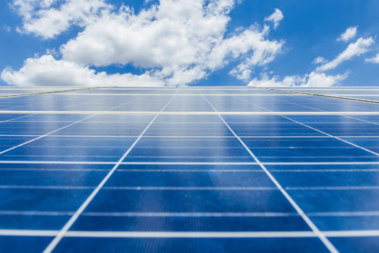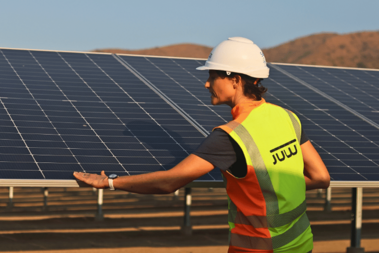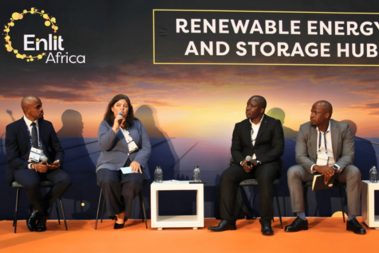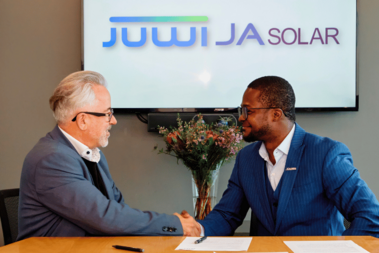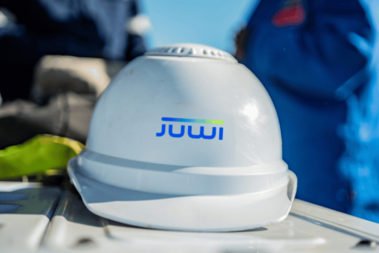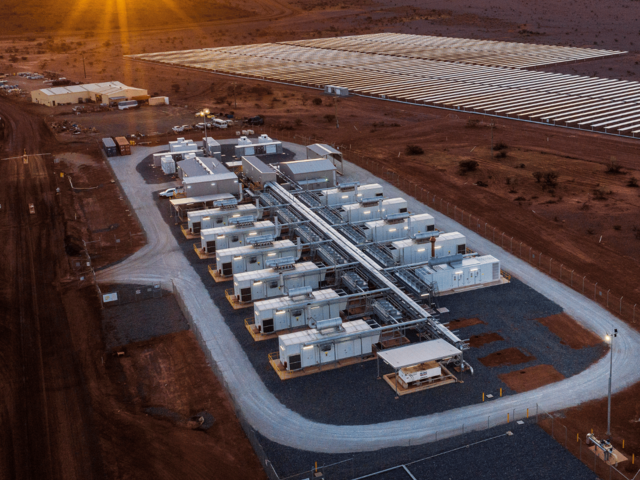
Mining for sustainability: Harnessing solar PV with battery storage
The mining industry plays a vital role in providing essential raw materials for various sectors, but it also consumes an astounding amount of energy, around 11% of the world’s total energy consumption. A considerable portion of this energy currently comes from fossil fuels and mines are responsible for 4-7% of global greenhouse-gas emissions. This energy also comes at a cost to miners, with energy constituting around 30-40% of a mines’ total cash operating costs.
Mines are increasingly recognising that reducing their carbon footprint is essential to combat climate change, cut costs, mitigate the threat of carbon import taxes by the US and EU, and to align with the expectations of stakeholders, investors and regulators. Major miners like Anglo American, Rio Tinto, BHP, and Sibanye are leading the way and have set net zero targets by 2040 or 2050. Renewable energy will play a significant role in helping them reach these targets – in South Africa alone, mining companies are planning to spend US$3.8 billion on renewable energy projects, with 585MW of solar projects either in the pipeline or already implemented.
Why energy storage?
The challenge with renewables is that they are intrinsically intermittent, following diurnal and weather conditions. In an operation such as a mine, even a brief disruption to the power supply can have enormous detrimental impacts. This makes energy security a paramount concern for operations, either in terms of health and safety such as underground ventilation, where there could be a loss of life when operations fail, or where there may be irreversible processes set in motion if energy is lost.
Battery energy storage systems (BESS) can offer increasing levels of support to address intermittency and risk by storing excess solar energy during sunny periods and discharging it when needed. Unlike thermal systems like diesel or heavy fuel oil that have thermal inertia and take time to start up, BESS offers instantaneous reaction to changes and can also provide frequency and voltage control. As prices come down, larger batteries also become more economic and offer peak-shifting or back-up power. In the event of grid failure or thermal system malfunction, battery storage can maintain critical operations for a period of time.
Sukari Gold Mine, Egypt
The 36MW/7.5MWh solar-plus-storage plant at Sukari Gold Mine near the Red Sea in Egypt demonstrates how solar PV and energy storage can address climate change and offer cost savings, while managing intermittency. The mine is in a very remote location in the desert and has historically depended on diesel and heavy fuel oil for power, burning the fuel plants 24 hours a day. JUWI undertook the design, engineering, procurement and construction (EPC) and operations & maintenance (O&M) for the solar project at Sukari, which is a model for other mining operations in Africa and worldwide.
Making the most of the region’s excellent solar irradiance, the plant (which at the time was the largest hybrid project in Africa) maximises energy generation with bifacial solar PV modules and a single axis tracking system. JUWI’s Hybrid IQ micro-grid technology enables integration of the solar and battery system into the existing off-grid network and supports the operation of the existing power station. The team used cloud forecasting for the first time to assist with intermittency.
The plant has been delivering a consistent 36MWdc, converting to 30MWac of power. This reduction in exposure to volatile fuel pricing is saving the mine up to 70,000 litres of diesel per day and averaging a reduction in diesel consumption of 22 million litres per year.
Based on current diesel prices, this means the plant has the potential to provide annual cost savings of $20 million, alongside an expected reduction in Scope 1 greenhouse gas (GHG) emissions of 60,000 t/y CO2 equivalent and a subsequent reduction in volume of diesel trucked to site. That is saving 2 million trees a year or nearly 140,000 barrels of oil not consumed!
Lessons
Sukari provides a great example of a successful PV-plus-BESS project for a mine, but what are the important considerations and challenges that mines should be aware of? As a team, the JUWI Group has learnt some key lessons, having implemented 20 hybrid projects in the last nine years.
Prioritise fossil fuel displacement
The key is not to try to start with a renewables-only solution but to determine how much of the current fossil fuel solution can be displaced with alternative technologies. For PV only, this displacement can reach 30 – 40% but with batteries it can go up to about 60%. If wind is added on top of solar and storage, then penetrations of 80 – 90% are possible at a cost that is comparable with fossil-based solutions. Currently, most of the battery solutions being implemented use lithium-based technology however vanadium flow batteries and other chemistries continue to be explored for larger systems.
BESS is readily integrated into suitable PV sites
To successfully deploy PV with storage systems in mining operations, several site-specific considerations and operational challenges need to be addressed. Land availability aside, some of these are the usual PV-related requirements of stable ground, no environmental concerns, easy connection to the mine substation, etc. BESS generally requires a much smaller footprint than the renewable energy component. Batteries are generally finding two types of applications – one for off-grid scenarios like Sukari and another for countries like South Africa, where batteries will increase solar penetration and lead to greater cost savings.
Integration of PV, BESS, grid and thermal is key for efficiency
The integration of PV and BESS and a mine’s other supplies (grid and/or thermal engines) is key. After successful integration, real-time monitoring and control systems (including for example cloud forecasting systems) enables efficient and optimised operation and allows for proactive maintenance. Battery technology has matured and high cycle life guarantees are provided subject to correct treatment and maintenance. BESS lifetimes can be expected to exceed ten years or more. Data analytics can identify performance issues and guide optimisation strategies. As battery technologies evolve, continuous monitoring of advancements is necessary to leverage cost reductions and performance improvements.
Affordability and finance are no longer major hurdles
Financial considerations have long been a barrier for greater renewables adoption by mines. The substantial upfront expenses, with a 10MW solar-only facility ranging from US$8 million to US$12 million, can potentially compete with funding needed for accessing the ore body. Additionally, the relatively short lifespan of mining operations does not align seamlessly with long-term project financing or the expected useful life of renewable assets. BESS system prices have been falling and are now below US$200 per kWh.
Rising commodity prices, coupled with a surge in electricity costs, have made capital available and improved the business case for self-funding renewable energy plants.
At the same time, more funded solutions are becoming available which eliminate the capital barrier. Power purchase agreements (PPAs) with durations of 15 to 20 years or even shorter have become increasingly common, further facilitating the adoption of renewable energy.
Independent power producers (IPPs) are increasingly aggregating demand from multiple energy customers or they’re wheeling electricity.
Finally, the introduction of redeployable systems will revolutionise the landscape for many mines, as these systems can be relocated and repurposed once the mine reaches the end of its lifespan.
Looking forward
The mining industry’s growing demand aligns seamlessly with the global rise in renewable energy demand, resulting in advancements in technology and cost reductions. Currently, according to Bloomberg New Energy Finance, the energy storage market stands at approximately 50GW per year, with projections indicating a surge to 350GW per year by 2030. During this period, it is expected the cost of a 4-hour lithium-ion battery storage system will drop by a further 40%.
Growing demand from mines and other energy intensive sectors will drive the need for longer-duration energy storage. While lithium-ion battery storage with 1-2 hours of capacity is currently the most suitable solution for the majority of applications, the market may open up further to alternative technologies such as sodium-ion, vanadium flow, hydrogen, pumped hydro, and more recently, gravity storage as alternatives for some sites.
Scalable and modular PV-with-storage solutions will allow more mining companies to customise their renewable energy systems to suit specific requirements. With mines encompassing diverse operations with varying energy demands, this adaptability ensures that renewable energy solutions can be implemented in both large-scale and small-scale mining operations.
To conclude, mines are standing on the edge of a revolution that will likely see mining operations globally powered by clean energy and advanced storage technologies in just a decade or two. One of the largest challenges the mining industry has had to overcome is that it has, historically, been a conservative industry where mines like to be “first to be third” in adopting new tech. This was to some extent the case where renewables were concerned, but current cost, climate and intermittency imperatives mean that mines are evolving and stepping up to be first as far as energy storage is concerned.
This article was first published on PV Tech



